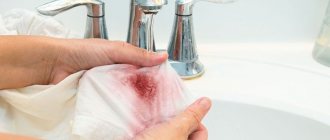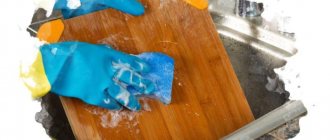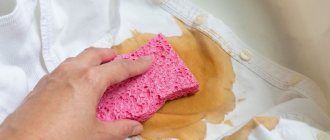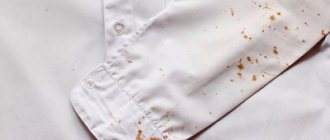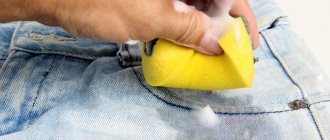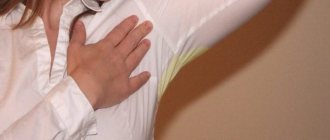Useful tips
It is believed that white clothes are cooler in hot weather than dark-colored clothes.
However, such clothes are not very practical and often get dirty. It is quite difficult to maintain a pure white color, and sometimes even bleach and numerous washes do not always help.
In this article we will try to figure out how to clean white clothes so that there are no stains on them.
First steps
To get started, you'll want to stock up on the following: baking soda, hydrogen peroxide (hydrogen peroxide), vinegar, salt, dish soap, oxygen bleach, and a few lemons.
How to remove sweat stains from white clothes?
Sweat marks are the fear of every woman, because they are especially visible on white clothes. The best way to get rid of sweat stains is to promptly wash your clothes using washing soap and leave them for several hours. But what to do if it was not possible to remove the stains in time?
Methods to help remove sweat from light-colored clothes
The first thing we must determine is the type of material from which the item is made.
A good stain remover is peroxide. Mix it with water and apply. Fairy works well on sweat marks.
Aspirin is an excellent remedy for removing sweat stains, including yellow ones. It is necessary to dilute it with water and soak for a period of one to two hours. Then the items must be washed with running water.
You can try using toothpaste and cotton pads, as the paste contains antifreeze, which can help break down complex contaminants.
Important Tips
It would probably never even occur to anyone to wash a white shirt with colored clothes, no matter how dirty it is. It would be useful to familiarize yourself with other useful recommendations on how to properly approach washing a shirt so that it does not look worse than it did before washing:
- Do not mix almost clean shirts with heavily soiled ones.
- It is better to remove stains from the wrong side of the product, moving from the outer contour to the center.
- Add a little bleach to the detergent if the shirt is no longer new and has taken on a gray tint.
- Wash at low temperatures, 30 - 40°C. Applies to both hand and machine wash.
- All buttons must be fastened.
- A delicate wash cycle is preferable. Drying and spinning are undesirable; it is better to squeeze out excess water yourself, being careful not to overtighten the fabric.
- When using additional products for bleaching or stain removal, extreme care must be taken to maintain the concentration of the solutions. Do not keep it longer than prescribed according to the instructions.
- Ironing the shirt only after it has completely dried will prevent it from developing a gray tint.
How to remove coffee from white clothes
How many things have you already thrown away that had coffee stains on them? It is this contamination that is considered one of the most serious, but if you know the tricks of dealing with it, you can easily save the thing.
Boiling and bleaching is the main method for removing coffee stains on white clothes. You can use boiling for natural fibers, and use bleach on white clothes.
By heating the water sufficiently to high temperatures - 90-110 degrees, you can effectively get rid of contamination. If chlorine bleach was used during bleaching, it is important to rinse the item as thoroughly as possible so that skin irritation does not occur afterwards.
Removing yellowness
Very often, yellow spots are found on a seemingly clean item. The reasons for this are that they forgot to wash the item or did not wash and rinse it properly. Most often, regular washing at the highest temperature setting helps get rid of yellow stains. If the item can only be washed in cool water, it is recommended to use mild bleaches - vinegar, hydrogen peroxide, special bleaching liquids for this material. A mixture of vodka and vinegar will help to refresh the yellow folds of collars.
How to get rid of stains
The best option is to wash things as quickly as possible, before the coffee has time to completely saturate the fibers.
An excellent way to remove stains is to use laundry soap.
The maximum effect can be achieved with glycerin and ammonia. Dilute glycerin with water, add ammonia, and then apply to the stain.
If coffee has managed to saturate the fabric, it will be more difficult to deal with. For old stains, you can try the following:
- Laundry soap
- Glycerol
- Borax
- Ammonia
- Lemon juice
- Acetic acid
- Salt
- Soda
- Nail polish remover
- Peroxide.
These substances will help get rid of coffee stains on any material. Even if several weeks have passed since the contamination occurred.
Laundry soap
To remove stains, it is necessary to use laundry soap, because it contains fewer additives. To prepare a detergent, you need to grate the soap and pour boiling water over it. After cooling, apply. Rinse with water.
Glycerol
You can use slightly warmed glycerin to remove coffee stains. Wipe with a cotton pad soaked in glycerin. After this, leave the clothes for 30 minutes and let the glycerin act, wash with powder.
Glycerin in combination with salt copes well with old stains. The product is applied and left for 20 minutes.
Borax
It can not be found in every apartment. But if you are lucky enough to find it, it is an excellent stain remover. First, you need to go over the stain with a cotton pad, alcohol, and then brown. Be sure to wash your clothes with powder.
Ammonia
An excellent method for removing stains. It is necessary to heat 500 ml of water. Add 50 ml of ammonia and rub the laundry soap. Mix the resulting mixture well and cool.
After this, apply the product to areas of clothing. You may need to re-process.
Turpentine oil
Apply using a sponge. You can buy it at any pharmacy. Be as careful as possible with it, because it is a toxic substance.
Hydrogen peroxide
Peroxide is an excellent stain remover that can be found in every home. Please note that it may discolor the item, but for white outfits this does not matter. Its advantage is a gentle effect on the material, which cannot be said about the means we talked about earlier.
Lemon acid
First wipe with an ice cube. Pour in lemon juice and leave for a few minutes. After this, wash with powder.
Vinegar
Acetic acid can be added to the powder during washing. Add soda, acetic acid. The result should be a thick mixture. Apply and leave for 10 minutes.
Useful tips
When cleaning from grease stains, there are specific secrets. They will help increase the effect of the procedure and accelerate the action of fat-dissolving reagents.
Degreasing
Since the basis of grease is fat mass, it is necessary to first remove traces of it on clothing. Kitchen dishwashing detergent will work for this. A small amount of gel is lightly rubbed into the fabric, then washed off with water. And it will be easier to remove residual traces of grease.
Steaming
Steam combined with solvent helps remove stains faster than conventional methods. To do this, moisten the problem area with warm turpentine, then place it over steam for 5 minutes.
From edge to center
It is very important to wipe the stain in a certain way - from the periphery to the center. Do not apply significant force so as not to damage the fabric and rub fat into the fiber structure
How to rinse and dry correctly
In most cases, rinsing is done with plenty of cool water, without applying much effort. Delicate fabrics (silk) require special handling and should be dried away from heat sources.
Wash in warm water after cleansing
Treatment in any composition is completed by washing in warm water with the addition of detergent. Thus, the consequences of the penetration of grease and the remaining stains from the fabric are completely eliminated. If this procedure is not followed, particles of dissolved fat will remain on the fibers, as well as the grease itself.
You need to wash your jeans from the inside out
This is necessary to prevent the stain from expanding. When wiping grease, try not to put much effort: it is better to gently, periodically changing the swab, systematically wipe the stain from the surface.
Share link:
Purchased and professional products
It doesn’t matter how long ago the stain was left, you can use special stain removers in any case. Bleach works well on coffee stains.
Bleaches
When choosing bleach, you must pay attention to:
- Preparations containing chlorine are only suitable for cotton and linen;
- Oxygen bleaches can be used on fabrics of any color.
Vanish Oxi Action is great for wool clothes.
When using bleach and other store-bought products, you need to carefully check whether they are suitable for cleaning upholstered furniture.
Stain removers - professional stain removal products
Selected depending on the type of fabric. Be sure to read what is written on the package. Most often it is necessary to apply and then wash using the usual method.
Table: overview of stain removers that can handle coffee stains
| Name | Purpose | Cost, r. |
| Vanish Gold Oxi Action | It must be mixed with water, then applied and washed using the usual method; Some buyers say that the product is less effective on old stains; Not suitable for silk products. | 500 |
| "Antipyatin" | The product is made on the basis of natural bile; It copes well with dirt, despite the fact that it is inexpensive; Can be used for all materials. | 70 |
| HG OXI | Can be used when soaking things with powder; Active oxygen is added during manufacturing; Eliminates unpleasant odors; Can be used for white and colored laundry. | 270 |
How to wash in a washing machine
Automatic machines create ideal conditions for washing white fabrics. When choosing a mode, take into account the composition of the fabric and the manufacturer’s recommendations.
Mode selection
Most modern fabrics have a mixed composition. When choosing a mode, they focus on that part of the components that require the most careful handling.
If the composition of the fabric is known, select the appropriate indicator on the machine. It is better to wash materials that contain even a small part of synthetic components in the “Synthetic” mode.
Temperature
The temperature is selected according to the composition of the fabric and the indicator on the labels. Basic Rules:
- linen – 40-60 °;
- cotton – up to 90 °;
- synthetics and mixed fabrics – 40-60 °.
Do not exceed recommended temperatures; white items may turn yellow and deteriorate.
Help: most modern detergents effectively remove all contaminants already at 40°.
How to remove a grease stain on white clothes?
There are a large number of methods for removing grease stains and the choice of method depends on the type of material. First of all, it should be noted that it is easiest to deal with fresh contamination. Sprinkle in some salt as soon as the stain has been discovered. This will help reduce pollution. Then you can resort to professional preparators.
We suggest preparing a product with your own hands that will help get rid of dirt. There are two most proven methods of dealing with traces of grease - laundry soap and ammonia, turpentine.
Grate laundry soap. Dilute with water and heat, add ammonia. After this, apply to the problem area. Leave for a few minutes and rinse with running water.
If using salt the stain was reduced in size, we recommend using turpentine. Moisten the area around with cold water so that the mark does not increase in diameter. Moisten a sponge in turpentine and begin to scrub away the dirt little by little.
What is used
To wash and bleach things manually and not spoil them, you need to know which fabrics can be exposed to high temperatures and what you will need for this.
Boil down
Before you start boiling, you need to select a container that can hold at least a bucket of water. An enameled pan without chips, cracks and rust, galvanized boiling water, is suitable for this purpose.
Wooden tongs
In order for the laundry to boil evenly, you need to mix it and take it out not with your hands, but to specially select a device in the form of a stick, a large wooden spoon or tongs.
Stubborn dirt
We offer several recipes for a quality stain remover. We also described how to effectively remove old and greasy stains in a detailed article about this problem.
List of actions that can be used to remove stains
- 1) Rub laundry soap. Fill with water and place on the stove.
- 2) Cool and then immerse clothes in water. Apply dissolved aspirin to the stain. Leave for two hours and then wash with powder.
Method of soaking things in acetic acid
Dilute acetic acid with water. Soak clothes in this mixture for 20 minutes. Apply ammonia to the stains. After this, rinse with citric acid. Leave for three hours and then wash with powder.
Rust removal
When washed, rust stains spread even further through the fibers. Contaminants must be removed in advance. To remove rust, acids are used - oxalic, citric.
Wedge of lime or lemon
Citrus slices are good at removing fresh traces of rust. Cut a piece from a lemon or lime, wrap it in gauze, apply it to the stain and press it with a hot iron. If necessary, cut off a new slice and repeat the processing.
Lemon acid
In the absence of lemons, use citric acid. Make a solution - 20 grams per 100 milliliters of water. Bring the solution to a boil, cool slightly, and lower the stained area for 5-8 minutes.
Let's summarize
As you have already seen, it is quite possible to remove coffee stains. Even if it's an old trail. The main thing is to start fighting pollution as early as possible. There is no need to panic, much less throw away your clothes. With so many methods, you can definitely choose the right one for the situation that can restore the cleanliness of your clothes!
5 1 vote
Article rating
Preparation
Before washing shirts, inspect the contents of the pockets. Make sure there are no foreign objects in them. Most often, these are paper handkerchiefs, notes, banknotes, which can cause problems in the washing machine and damage to clothing. Unfasten the cufflinks, do not leave the sleeve folded, straighten the collars, fasten all the buttons.
There are several reasons for turning clothes inside out:
- protection of buttons from scratches and wear (friction against the washing machine drum);
- exposure of the detergent directly to the armpits, which allows you to get rid of deodorant and sweat as effectively as possible;
- reduced impact on the outside of the shirt (minimizing fabric wear).
